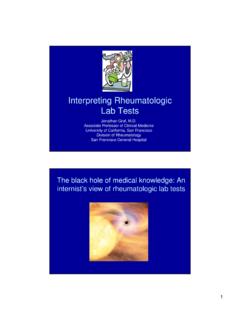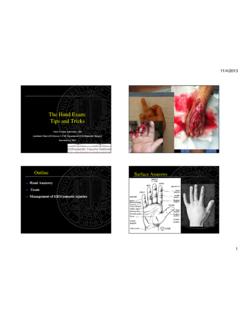Transcription of Three -Tier Fetal Heart Rate Interpretation Applying the ...
1 1 MichaelD. Fox RN, BSNA pplying the NICHD Categories Case Studies In Fetal MonitoringIIIIIIN ormalAbnormalIndeterminateNICHD 2008 Three - tier Fetal Heart Rate Interpretation SystemNICHD 2008 Three - tier Fetal Heart Rate Interpretation SystemINICHD 2008 NICHD 2008 Normal Category I Moderate Variability FHR 110-160 bpm No late or variable decelerations early decelerations accelerationsCategory I Moderate Variability FHR 110-160 bpm No late or variable decelerations early decelerations accelerationsNICHD 2008 NICHD 2008 Category III Absent variability with recurrent: Late decelerations Variable decelerations Bradycardia OR Sinusoidal patternCategory III Absent variability with recurrent: Late decelerations Variable decelerations Bradycardia OR Sinusoidal pattern Abnormal III2 NICHD 2008 NICHD 2008II Indeterminate Category II TracingsEverything elseCategory II TracingsEverything else The Mess In the Middle The Mess In the Middle IIIIII Abnormal Indeterminate Normal 2008 NICHD 3 tier System Fails To: 2008 NICHD 3 tier System Fails To: Clearly identify the relationship between FHR patterns and significant acidemia.
2 Clearly identify the relationship between FHR patterns and significant acidemia. Simplify and make clear the framework for determining the choice and timing of our interventions Simplify and make clear the framework for determining the choice and timing of our interventions2008 NICHD 3 tier System Fails To: 2008 NICHD 3 tier System Fails To: Clearly identify the relationship between FHR patterns and significant acidemia. Clearly identify the relationship between FHR patterns and significant acidemia. Simplify and make clear the framework for determining the choice and timing of our interventions Simplify and make clear the framework for determining the choice and timing of our interventions?Minimal FHR variability (with decelerations) should be considered as potentially indicative of Fetal acidemia and should be managed FHR variability (with decelerations) should be considered as potentially indicative of Fetal acidemia and should be managed FHR variability reliably predicts the absence of Fetal metabolic acidemia at the time it is FHR variability reliably predicts the absence of Fetal metabolic acidemia at the time it is FHR variability with is abnormal and conveys an increased risk of Fetal acidemia at the time it is FHR variability with is abnormal and conveys an increased risk of Fetal acidemia at the time it is Patterns and AcidemiaFHR Patterns and Acidemia2008 NICHD Report EFM JOGNN, 37, 1-6; 2008.
3 2008 NICHD Report EFM JOGNN, 37, 1-6; 2008. NICHD -ACOG Practice Bulletin #116 November 2010 NICHD -ACOG Practice Bulletin #116 November 2010 NICHD -ACOG Practice Bulletin #116 November 2010 Simplify the Framework3 Clinical CategoriesSimplify the Framework3 Clinical Categories3 Minimal FHR variability (with decelerations)should be considered as potentially indicative of Fetal acidemia and should be managed FHR variability (with decelerations)should be considered as potentially indicative of Fetal acidemia and should be managed FHR variability reliably predicts the absence of Fetal metabolic acidemia at the time it is FHR variability reliably predicts the absence of Fetal metabolic acidemia at the time it is FHR variability ((with ) is abnormal and conveys an increased risk of Fetal acidemia at the time it is FHR variability ((with ) is abnormal and conveys an increased risk of Fetal acidemia at the time it is -AWOHNN -AACN Interpretive PrinciplesACOG -AWOHNN -AACN Interpretive PrinciplesFactors Increase Likelihood for Significant Acidemia Factors Increase Likelihood for Significant Acidemia 2008 NICHD Report EFM JOGNN, 37, 1-6; 2008.))
4 2008 NICHD Report EFM JOGNN, 37, 1-6; 2008. NICHD -ACOG Practice Bulletin #116 November 2010 NICHD -ACOG Practice Bulletin #116 November 2010 NICHD -ACOG Practice Bulletin #116 November 2010 decelerations That progress to a greater depth and longer duration Are more indicative of impending Fetal 2010-ACOG Practice Bulletin #116 November 2010 NICHD 2010-ACOG Practice Bulletin #116 November 2010 Evolutionof Significant Acidemia? Evolutionof Significant Acidemia? Typical and observable changes associated with an increased risk for birth in the presence of a significant Fetal acidemia? Typical and observable changes associated with an increased risk for birth in the presence of a significant Fetal acidemia? 1. Evolutionary loss of FHR variability2. In association with recurrent decelerations and/or bradycardia 3.
5 That get deeper over time In Association Decelerations That Get Deeper Over TimeModerateAbsentMinimalPattern EvolutionEvolutionary loss of VariabilityModerateAbsentMinimalNoNoMayb ePresumed PresumedMake a Presumptive Diagnosis of the FHR Patterns Relationship to Significant AcidemiaBased On the Degree of Variability Accompanies the DecelerationsMaybe4In a fetus with an initially normal FHR pattern the development of significant acidemia evolves over a period of time, of the order of at least one hour. (60 90 minutes)In a fetus with an initially normal FHR pattern the development of significant acidemia evolves over a period of time, of the order of at least one hour. (60 90 minutes)Estimated time to deliveryEstimated time to deliveryLocal realities = Event to delivery timeLocal realities = Event to delivery timeChoice and Timing of Interventions: Factors to Consider Choice and Timing of Interventions: Factors to Consider 1 Hour Window of Opportunity 1 Hour Window of Opportunity Applying the NICHD Categories Case Studies In Fetal MonitoringApplying the NICHD Categories Case Studies In Fetal MonitoringCASE 1 CASE 1 Patient ProfilePatient Profile 25 y/o G1 P0 Admitted @ 39 3/7weeks Labor Epidural 25 y/o G1 P0 Admitted @ 39 3/7weeks Labor Epidural 10:1210.
6 12 Continuous monitoring Yes No Continuous monitoring Yes No Recurrent decelerations - 50% UC s in 2 consecutive 10 minute windows 5MD/CNM notification Yes No MD/CNM notification Yes No 10:1210:12 Bedside evaluation Yes No Bedside evaluation Yes No 10:1210:12 Preparation for Delivery Yes No Preparation for Delivery Yes No 10:1210:12 Delivery Yes No Delivery Yes No MD SVE -Leaves room10:12 10:12 Complete. Feels urge to push10:17610:30 13 minutes later10:30 13 minutes later10:30 18 minutes later10:30 18 minutes laterEnsure ability to rescue fetus Yes No Ensure ability to rescue fetus Yes No 11:10 40 minutes later11:10 40 minutes later12:00 50 minutes later12:00 50 minutes later713:00 60 minutes later13:00 60 minutes laterNeonatal Resuscitation Available Yes No Neonatal Resuscitation Available Yes No 13:37 birth13:37 birthIs this tracing associated with Significant Acidosis?
7 Yes No Maybe4%9%87%A. YesB. NoC. MaybeA. YesB. NoC. MaybeDelivery OutcomeDelivery Outcome 3535 gm. female By low forceps for prolonged second stage and maternal exhaustion (3 hrs. 25 minutes) Apgar Score 9/9 3535 gm. female By low forceps for prolonged second stage and maternal exhaustion (3 hrs. 25 minutes) Apgar Score 9/9 Cord GasesCUA: : Cord GasesCUA: : 82006 - Fetal acidemia and electronic Fetal Heart rate patterns: Is there evidence of an association? J. T. Parera;T. King a; S. Flanders a; M. Fox a; S. J. Kilpatrick b The Journal of Maternal- Fetal Medicine, Volume 19, Issue 5 May 2006 2006 - Fetal acidemia and electronic Fetal Heart rate patterns: Is there evidence of an association? J. T. Parera;T. King a; S. Flanders a; M. Fox a; S. J. Kilpatrick b The Journal of Maternal- Fetal Medicine, Volume 19, Issue 5 May 2006 Moderate FHR variability reliably predicts the absence of Fetal metabolic acidemia at the time it is FHR variability reliably predicts the absence of Fetal metabolic acidemia at the time it is NICHD Report EFM JOGNN, 37, 1-6; 2008.
8 2008 NICHD Report EFM JOGNN, 37, 1-6; 2008. 98% of the fetuses with moderate FHR variability, with or without decelerations or second stage bradycardia will be born in the absence of a significant metabolic acidemia, and/or in the presence of neonatal vigor. When moderate FHR variability is present at the time of birth<1% of neonates will be born with an Apgar score <7 at 5 minutes. 98% of the fetuses with moderate FHR variability, with or without decelerations or second stage bradycardia will be born in the absence of a significant metabolic acidemia, and/or in the presence of neonatal vigor. When moderate FHR variability is present at the time of birth<1% of neonates will be born with an Apgar score <7 at 5 2 CASE 2 Applying the NICHD Categories Case Studies In Fetal MonitoringApplying the NICHD Categories Case Studies In Fetal MonitoringPatient ProfilePatient Profile 16 y/o G1 P0 @ 40 6/7 weeks arrives in triage contracting strongly SVE in triage 5/100/-2 AROM thick mec FSE/IUPC are placed - amnioinfusionbegun Complete within 3 hours admission 16 y/o G1 P0 @ 40 6/7 weeks arrives in triage contracting strongly SVE in triage 5/100/-2 AROM thick mec FSE/IUPC are placed - amnioinfusionbegun Complete within 3 hours admissionTime: 23:50 complete and pushingTime: 23:50 complete and pushing900:20: 30 minutes :20: 30 minutes :40: 20 minutes :40.
9 20 minutes :20: 40 minutes later01:20: 40 minutes later01:30: 10 minutes later01:30: 10 minutes later1001:50: 20 minutes later decision C/S01:50: 20 minutes later decision C/S01:59: 9 minutes later Terbutaline given) 01:59: 9 minutes later Terbutaline given) To OR02:20: 21 minutes later 02:20: 21 minutes later 02:28: 4 minutes later delivery 02:28: 4 minutes later delivery 11Is this tracing associated with Significant Acidosis? Yes No Maybe83%14%3%A. YesB. NoC. MaybeA. YesB. NoC. MaybeDelivery SummaryDelivery Summary 1 hr. 20 minutes of recurrent decelerations with minimal -absent variability Male Apgar score 3/7/8 Cord Gases: CUA : CUV : 1 hr. 20 minutes of recurrent decelerations with minimal -absent variability Male Apgar score 3/7/8 Cord Gases: CUA : CUV : the NICHD Categories Case Studies In Fetal MonitoringApplying the NICHD Categories Case Studies In Fetal MonitoringCASE 3 CASE 3 29 y/o G 2 P1 @ 39 3/7 wks.
10 Spontaneous labor 29 y/o G 2 P1 @ 39 3/7 wks. Spontaneous laborPatient ProfilePatient Profile1217:3017:3022:20 AROM 22:20 AROM Inadequate uterine monitoring22:3022:3002and IV increased 02and IV increased 22:5822:581323:1023:1023:2023:2023:30 SVE 3/90%23:30 SVE 3/90%23:4023:4014 Category I II IIIC ategory I II IIIS ignificant Acidemia Yes NO Maybe Significant Acidemia Yes NO Maybe XXXXXXXX23:4623:4623:5023:501524:00 SVE 4 cm plan C/S24:00 SVE 4 cm plan C/S00:03 SQ Terbutaline00:03 SQ TerbutalineTo ORTo OR00:09 Positioned for spinal00:2000:2000:28 delivery00:28 delivery16171819Is this tracing associated with Significant Acidosis? Yes No Maybe12%41%47%A. YesB. NoC. MaybeA. YesB. NoC. Maybe C/S for Fetal distress.











